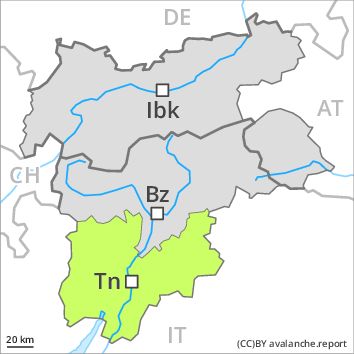Regions
Latemar, Southern Adamello, Primiero - Pale di S. Martino, Adamello - Presanella, Prealps, Northern Brenta - Peller, Cembra Valley, Bondone and Stivo, Vallarsa, Western Nonsberg Alps, Folgaria - Laverone, Southern Brenta, Fassa Valley, Sole, Pejo and Rabbi, Southern Lagorai, Ledro Valley, Northern Lagorai, Maddalene, Paganella, Marzola - Valsugana, Pine' - Mocheni Valley

Danger level

The snowpack will be quite stable. Fresh snow towards the evening. For this reason the danger will increase.
The Avalanche Warning Service currently has only a small amount of information that has been collected in the field.
The wind slabs must be evaluated with care and prudence at high altitudes and in high Alpine regions. These can in very isolated cases be released, in particular by large loads, especially on very steep shady slopes in pass areas. Mostly the avalanches are small.
Intermediate altitudes and below approximately 2200 m: As a consequence of warming during the day and solar radiation there will be only a slight increase in the danger of gliding avalanches and moist snow slides, in particular on steep sunny slopes. Gradual increase in avalanche danger as the snowfall becomes more intense. The prevalence of avalanche prone locations will increase during the course of the night.
Snowpack
Very steep shady slopes: The wind slabs are lying on soft layers. In very isolated cases weak layers exist in the old snowpack, in particular on steep shady slopes above approximately 2200 m.
East, south and west facing slopes: The wind slabs are lying on a crust. The surface of the snowpack will freeze to form a strong crust and will soften during the day.
At low altitude no snow is lying. Night: 10 to 20 cm of snow, and even more in some localities, will fall above approximately 1000 m.
Tendency
Gradual increase in avalanche danger as a consequence of the snowfall.